 |
| Summer 2000 |
Vol. IX, No. 2
|
|
In This Issue:
Strategic Fire Planning Process
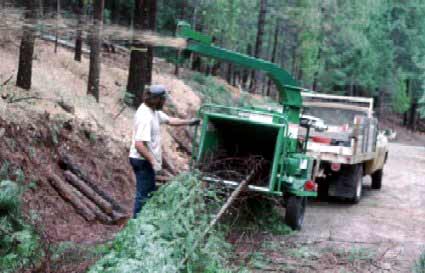 |
Chipping at a fuel break along Long Canyon Rd.
The Trinity County Fire Safe Council has made significant progress toward the development of a strategic fire plan for Trinity County. In May, five regional meetings were held in North Lake, Mid Trinity, South Fork, Southern Trinity, and Down River areas to identify and map values at risk and locations of key infrastructure relevant to fire response; to propose activities to minimize the risk of catastrophic fires; and to prioritize proposed projects within each portion of the county. The planning process to date has brought together community members, fire and forestry experts from CDF, USFS, Volunteer Fire Departments, and the private sector.
As we all know, large fires have occurred in Trinity County in the past and will likely occur again. The mix of residential development, timberlands, hot summer weather and high ignition risk make fire and fuel management an important concern for residents of this area. California Department of Forestry and Fire Protection (CDF), U.S. Forest Service (USFS), and private foresters have come to recognize that the expansion of homes into the ’wildland-urban interface’ has created potential for devastating loss of lives, dwellings, and forest resources. Foresters, ecologists, wildlife biologists, and fire managers are developing new strategies to allow safer coexistence of people and wild lands. Prescriptions for maintaining healthy, fire resistant forest conditions generally call for reduced tree densities and use of low intensity prescribed fire. The desired stands will appear more open and park-like, with increased forage production for deer
and other wildlife. These practices also reduce the intensity of wildfire.
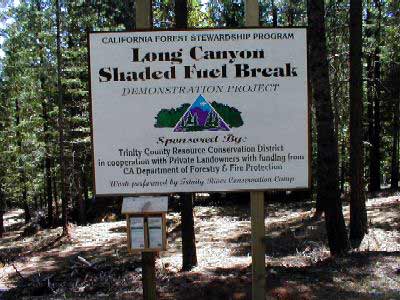 |
Informational sign installed at the Long Canyon Demonstration Project
Fuels Reduction Demonstration projects are currently underway in the Covington Mill/Long Canyon community and along East Branch Road in Weaverville. A detailed Fire Management Plan has recently been completed for the Covington Mill/Long Canyon/Lake Forest Estates area. The Plan recommends future fuel breaks, fuel ladder reductions, and other landscape-level treatments to reduce the threat of catastrophic fire and improve forest health. This plan will be incorporated into the county-wide strategic fire plan.
The Watershed Research and Training Center has begun to implement a fuels reduction and thinning project on 10 acres of the Jones Plantation on the South Fork Management Unit of the Shasta-Trinity National Forest to explore the use of small diameter material for value added products. Fuels reduction projects are being planned for Timber Ridge and Post Mountain neighborhoods as well as selected areas on public lands.
The strategic fire plan will be used for:
- input to the Safety Element of the Trinity County General Plan
- helping to identify and prioritize additional projects based on their location in the landscape and associated fire risk
- support for the Volunteer Fire Departments
- obtaining additional funds to implement necessary landscape treatment projects on public and private land
- enhancing coordination and effective use of limited resources
Education and outreach is an important objective of the Trinity County Fire Safe Council. As part of this effort a sign was installed before the long Forth of July weekend in the Long Canyon Demonstration Project, a roadside shaded fuel break. A brochure describing the Long Canyon shaded fuel break was produced as well, and has been placed at the informational sign for outreach and education of residents and casual visitors to this popular road for access to the Trinity Alps Wilderness area.
The Fire Safe Council is also working on developing a Power Point slide presentation to be used to give presentations to various community groups and to schools.
Funding for these various Fire Safe planning, implementation, and education projects has come from the State Water Resources Control Board, the Pacific Southwest Experimental Station, and California Department of Forestry and Fire Protection‘s Forest Stewardship Program.
Return to this Issue's Index |
Progress on the Weaverville Basin Trail System
Master Plan Completed
The USDA Forest Service, Shasta-Trinity National Forest provided a grant through the Community Economic Revitalization Team (CERT) program to Trinity County in 1998 to develop a Master Plan for the Weaverville Basin Trail System—A Trail Through Time on lands outside the management of the USFS. This conceptual plan is meant to complement the Environmental Assessment that was approved in 1996 for the trails on lands managed by the USFS, and to enhance the recreational experience of the Weaverville community and its visitors.
The Master Plan Release 1.0 was recently completed through the cooperative efforts of the Trinity County Resource Conservation District, Trinity County Resource Conservation & Development Council, USDA Natural Resource Conservation Service, Weaverville Basin Trail Committee, and residents of the Weaverville community. Representatives of these organizations, including Mr. Robert Snieckus, NRCS National Landscape Architect, recently provided a presentation on the Master Plan to the Trinity County Board of Supervisors.
Second Annual Fall Salmon Festival
The Fall Salmon Festival is being held on Saturday October 7th, 2000 from 9 a.m. to 6 p.m. to celebrate the age old salmon runs and the plentiful fall harvest. This event, sponsored by the Trinity County Arts Council, was a great success last year, and promises to be just as fun the second time around. This year’s festival, which is free to the public, will feature world-renowned Irish musician Mick Moloney, and music throughout the day by other great bands. There will be plenty of activities for the whole family, including hay rides, a “salmon tent,” watershed education, art displays, a farmer’s market, and more.
Energetic folks can kick off the day by participating in the Fall Salmon Fun Run. This event is open to participants of all ages and abilities, and will include a 5 kilometer Fun Run / Walk, which will follow a route through historic Weaverville and environs.
For more information on participating in the Salmon Festival or a Fun Run entry form, or applications for vendor or informational booths, contact Justin Martin at 623-6004, or email: fallsalmonfest@cheerful.com.
Return to this Issue's Index |
As the document makes clear, this Master Plan is a conceptual plan designed to show the potential of the Weaverville Basin Trail system. Although much public input (and several community scoping sessions) has gone into the development of this document, it is not cast in stone. It is a document subject to change, revision, and updating.
Copies of the Master Plan are available for viewing at the Weaverville and Hayfork branches of the Trinity County Library, the Planning Department, the Trinity County Resource Conservation District, and the Trinity County Resource Conservation & Development Council office. You also can request a copy of the plan on CD-ROM from the Resource Conservation District, or view highlights of the plan on the District’s web-site (http://www.snowcrest.net/tcrcd).
This Plan will be an effective tool for securing funds for trail development as well as to focus the efforts of the Trail Committee. The Trail Committee hopes that the information provided in the Master Plan will help us make the best possible decisions toward implementing the mission and vision of a basin-wide trail system.
The RCD will be applying for funds from the Park Service’s Recreational Trails Program to implement one of the high priority trail segments evaluated in the Master Plan (developing a trail from Oregon Street along West Weaver Creek to the Industrial Park complex).
Trinity Gateway Project
Trinity County is beginning to implement the Trinity Gateway Project. The project includes improved parking, a transit stop, lighting, improved trails, and landscaping, and informational kiosks at the Lee Fong Park and Lee Ranch House. This area is meant to be a major trailhead for the Weaverville Basin Trail system. This is a $300,000 project that is receiving $210,000 from a CalTrans Environmental Enhancement Mitigation grant. The RCD and Resource Conservation & Development Council will assist the county with portions of the project that pertain to landscaping, interpretive signage, and organizing the assistance of the community groups providing in-kind services for the Gateway Project.
Trail Condition Survey Maintenance Plan
The Trail Committee has nearly completed its assessment of the trail conditions for the USFS. Volunteers have biked or hiked sections of trail to identify locations in need of maintenance. Drainage problems, missing signs, and low branches have been the primary maintenance needs identified. These problems have been mapped and maintenance will be prioritized for implementation with the assistance of the USFS.
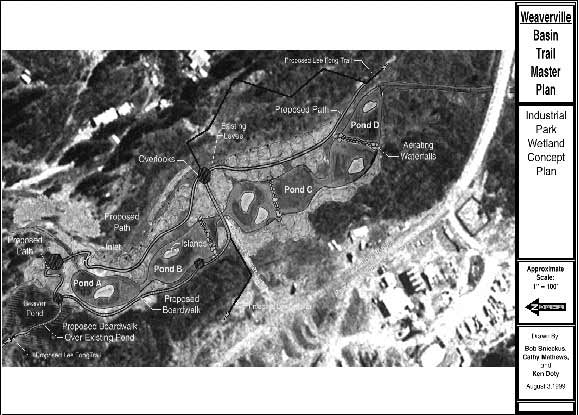 |
Conceptual design of wetland area from the Master Plan
Wetlands Reserve Program
The Natural Resources Conservation Service (NRCS) has offered Trinity County $500 per acre for 55 acres for a conservation easement to restore the area behind the Industrial Park in Weaverville as part of their Wetland Reserve Program. The NRCS would also contribute $75,000 to restore 7 acres of these wetlands. This area, which is near Weaver Creek and currently marshy with some ponds, is an excellent place to observe birds and other wildlife.
This project, if it is approved by the Trinity County Board of Supervisors, would become a part of the Weaverville Basin Trail System with paths and interpretive signage installed at appropriate locations. A conceptual design for the wetlands area is included in the Weaverville Basin Trail Master Plan.
New Bridge Installed
The USFS obtained funds to install a new bridge for pedestrians, bikes and horses over East Weaver Creek as part of the Weaverville Basin Trail system. The bridge was constructed this spring by the California Conservation Corps and is located off of East Weaver Road via a graveled driveway. This bridge enables access on USFS land to the trail up to Jackass Ridge.
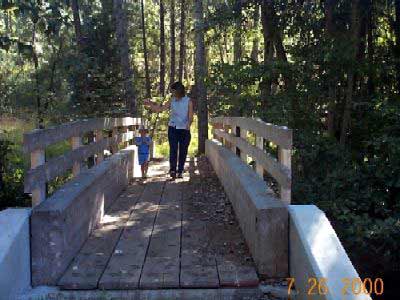 |
New bridge over East Weaver Creek
Hosting Field Trip for National Trails Symposium
The Weaverville Basin Trail Committee, the Chamber of Commerce and others are hosting a field trip called Historic Weaverville and the Weaverville Basin Trail for the National Trails Symposium that is being held in Redding this September. This trip will include a guided hike or mountain bike ride on the Weaverville Basin Trail system or a guided walk through Historic Downtown Weaverville. The National Trails Symposium attracts hundreds of trail enthusiasts from around the country every other year, and this field trip is an excellent opportunity to highlight Trinity County recreational opportunities.
Private Lands Easements Granted for the Weaverville Basin Trail
The Highland Snyder Foundation’s Board of Directors unanimously agreed to grant Trinity County an easement through property owned by the Highland Snyder Foundation Trust for the Weaverville Basin Trail. This easement is for roughly a mile long stretch of trail and important trail intersections through their property along Ten Cent Gulch. In addition to existing state laws that protect private landowners, private property owners who provide an easement for the trail, will be indemnified by the county from any liability associated with trail use.
The Weaverville Community Service District (WCSD) is providing trail easement through its property on the Day Ranch Trail along East Weaver Creek. The WCSD has also granted an easement to the county for trail access through its property at the end of Manzanita Street to the trail along the ridge by the reservoir, called Jackass Ridge. The previous trailhead had been blocked off with a gate.
The Trail Committee looked for ways to work around this obstacle and found a receptive landowner, who is willing to provide an easement to the trail, allowing residents and visitors the opportunity to continue enjoying this section of the Weaverville Basin Trail.
Trail access is a serious issue for communities and the Weaverville Basin Trail Committee has been working to keep access available to trail users while not infringing on landowners’ rights. The Trail Committee and other trail users are truly grateful to these landowners for providing the community with access to our amazing trail system.
Return to this Issue's Index
| A Day in the District
Trinity County RCD hosted their first “DAY IN THE DISTRICT” tour on May 12, 2000. Led by District and NRCS staff, Assemblyman Dick Dickerson, Trinity County Supervisors Chris Erickson and Ralph Modine, NRCS Assistant State Conservationist Linden Brooks, and several RCD Directors visited restoration projects that were recently completed.
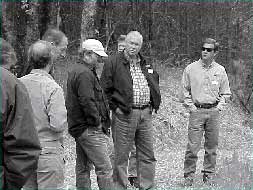
Assemblyman Dick Dickerson and others.
In addition to highlighting District projects and activities, the tour gave Directors an opportunity to discuss the importance of locally led conservation and the need for base funding with elected officials. Assemblyman Dickerson and our Supervisors were able to meet with landowners and see first-hand, completed projects on residents’ properties, including cattle exclusion fencing, fire rehabilitation work, emergency watershed protection (EWP), and a forestry incentive program (FIP). Other stops were made to observe and discuss the Covington Mills fuels management demonstration project, which is located in a rural residential community, and a project with Caltrans involving revegetation along highway 299.
Trinity Alps Resort owners Morgan Langon and Margo Gray hosted a buffet luncheon and showed attendees EWP work implemented at the resort by NRCS and Trinity RCD.
A special thanks to landowners Genie Hardt, Ray Petersen, and John Scott for showcasing the work done on their properties.
Return to this Issue's Index
|
South Fork Trinity River Resoration Projects Update
Inventory
The TCRCD was granted funds from California Department of Fish and Game’s Salmon and Steelhead Trout Restoration Account (SB-271) to inventory the roads on lands managed by the US Forest Service in the Rattlesnake Creek watershed. Data will be collected on roughly 240 miles of road including all active sediment sources associated with roads and stream crossings, adequacy of culvert sizes, diversion potential, and maintenance needs. The inventory data will be utilized for the Forest Service’s scheduled Watershed Analysis for Rattlesnake Creek. This analysis will be used to identify project opportunities and evaluate sites for project implementation that will improve fish and wildlife habitat.
The RCD has also applied for funds to implement road inventory on private lands in the Grouse Creek Watershed with the assistance of the South Fork Trinity River Coordinated Resource Management Planning group (CRMP).
Road Work
Maintenance level work (primarily reducing diversion potential) continues in the Hidden Valley compartment of the South Fork Trinity River Watershed on US Forest Service lands. Nineteen and a half miles of this work have been approved to date. A work plan has been submitted for decommissioning 5 roads totaling roughly 3.5 miles for the Upper South Fork watershed and is awaiting finalization of the Environmental Assessment. Other work approved for this summer includes 1 road decommissioning (1 mile) and 1 road hydroclosure (0.70 miles) in the Smoky/East Fork watersheds.
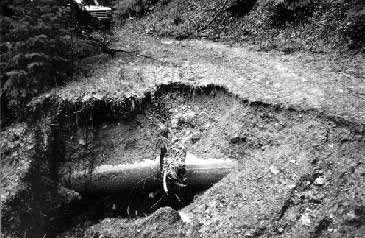 |
Problems identified on USFS roads included
this plugged crossing and failed culvert
Riparian Enhancement
Two pumps have been installed in the Hayfork Valley to provide water to livestock. Along with fencing, these projects enable landowners to keep livestock out of the creek, which reduces bank erosion and enhances riparian conditions. Both pumps utilize no electricity. A ram pump is powered by falling water. Livestock learn to pump their own water with the pasture pump by pressing their nose against a lever.
Fish Passage Enhancement
The RCD is implementing a fish passage enhancement project on Barker Creek on Hwy 3 at the confluence with Hayfork Creek. This project involves the reconstruction of an existing fish ladder, installing baffles in a box culvert, and building two rock and mortar weirs. This project will improve fish habitat and improve steelhead passage. This project is being funded from the California Department of Fish and Game’s SB 271 funds.
Monitoring
TCRCD recently received a grant from Trinity County to perform Turbidity and Suspended Sediment Monitoring in the South Fork Trinity River watershed. The goals of this project are to develop baseline data that will assist in: (1) Prioritizing restoration actions by identifying watersheds that have disproportionately high sediment yields; (2) Providing monitoring data to evaluate the effectiveness of restoration actions to date in various sub-watersheds; (3) Providing information useful for implementing the TMDL by identifying background and current turbidity levels in portions of the South Fork Trinity River and its tributaries; and (4) Facilitating education and empowerment of watershed residents by organizing a community-based volunteer program for monitoring turbidity. This information should ultimately assist in reducing the rate of sedimentation into the South Fork Trinity River and tributaries and accelerate the effectiveness of fish and wildlife restoration in the
River.
Return to this Issue's Index
Trinity County Backyard Conservation Program
The Trinity County Resource Conservation District would like to announce our new program, Trinity County Backyard Conservation. The District has long been committed to assisting landowners in the protection, management, conservation and restoration of the natural resources of Trinity County. The TC Backyard Conservation Program, which is funded by the California Department of Conservation, will increase our ability to help Trinity County resident with their conservation needs. District Staff can offer information and technical assistance to landowners in the following areas: erosion control to protect the soil and ensure high water quality; use of native plants for site stabilization and landscaping; riparian habitat improvement for wildlife and the health of our waterways; fuel load reduction to protect your home from forest fire; water quality monitoring; and water conservation to safeguard this valuable resource.
Residents of Trinity County are well aware of the beauty of our corner of the world. Unfortunately, some of our activities can negatively impact the health of our forests, the waterways, and the wildlife populations in our community. Additionally, many plant communities are threatened by the invasion of non-native, introduced plant species that affect biological diversity and significantly alter wildlife habitat.
For these and many other reasons, learning how to be a good land steward is important for any resident of our county. Educating our neighbors about sound land management practices and habitat enhancement is central to the District’s mission.
Look for us at the Trinity County Fair. We will be holding a raffle each day for people to vote on our new Backyard Conservation Logo. Participants will receive wildflower and native grass seeds. Daily raffle winners will be given native plants for landscaping.
Remember -- Conservation Begins at Home!!
Return to this Issue's Index |
Trinity High Student Wins Trip to Hawaii
Katrina Zimmer of Junction City took first place at the 16th annual California Range and Natural Resources Camp, held at Elkus Youth Ranch in Half Moon Bay, CA. Pleased not only to rank top among her peers in subjects such as ecology and rangeland management, Katrina is looking forward to her first place prize--a trip to Kona, Hawaii.
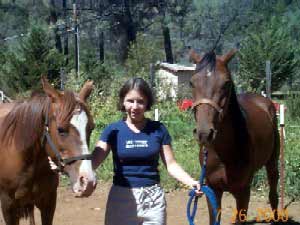 Katrina with her horses Chryssa and Asahm
Sponsored by Trinity County Resource Conservation District with the recommendation of her FFA advisor and Trinity High School Agriculture Science teacher, Mike Rourke, Katrina attended camp June 18 –23, 2000. Range Camp is designed to introduce young men and women to the importance and value of California’s rangeland resources. The program encourages leadership and good stewardship through the interaction with recognized professionals in both classroom and field sessions. Ecology and practical land management skills are emphasized and include: plant identification, livestock management, wildlife, fire, range analysis and improvement. “Camp was a great experience, and I would recommend any student attending,” says Katrina. After completing high school, she plans to study equine science and drama, and perhaps become a large animal veterinarian.
The daughter of Karen Zimmer, Katrina will attend The Society for Range Management’s Annual meeting while in Hawaii and participate in the Youth Forum International Range Camp. Katrina is preparing a slide show presentation for the Forum.
|
District Manager's Corner
by Patrick Frost
Here at the District we have had a very busy and rewarding spring and summer. Last year we set a goal of reaching out to more members of our communities. To do so we knew that we would have to diversify our funding, and I am pleased to tell you that we have been successful in this effort. This issue describes a wide range of projects in which the District has been involved. I am particularly excited about two new grants. The Backyard Conservation program is designed to bring information and technical assistance to your backyard – to help you with some thorny issues like how you might control Himalayan blackberries along your stream; or what kinds of native plants you can incorporate into your landscaping to attract songbirds. The Backyard Conservation project is being coupled with another – the Riparian Education and Outreach project being funded by the National Fish and Wildlife Foundation (NFWF). This outreach and education project
focuses on the care and management of streamside areas, especially for those of us who live on creeks and rivers. Through these two projects District staff can come out and work with you individually and we are available to speak to your group or organization. Give us a call at 623-6004 if you would like our assistance.
What better way to teach about streams and the importance they play in Trinity County than to spend a couple of days with 54 enthusiastic students out in the field. That’s just what we did to kick-off the NFWF streamside education project this spring. The District was invited to help teach the 6th grade classes of David Newton and Jean Yoho at Weaverville Elementary School during their May trip to Bar 717 Ranch near Hyampom.
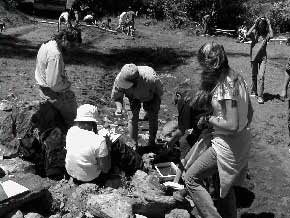 |
Students at the Environmental Camp at Bar 717
For two days children, teachers, and chaperones had the opportunity to study Hayfork Creek and its surroundings with Justin Martin and Trina Hedrick, AmeriCorps Watershed Stewardship members, and myself. Together we measured the creek, looked at the health of streambank vegetation and collected some aquatic bugs. You can’t study a stream without getting a little wet, and more than a couple of kids “accidentally” fell into the water in the afternoon heat. At one station, everyone learned how to measure the clarity of the water with the District’s turbidimeter, a common scientific instrument used to study water quality.
It was rewarding to see the excitement in the faces of students when they caught a crayfish; found the nest of a Spotted sandpiper on the beach; watched a Black Phoebe building a nest on the overhanging branch of a sugar pine; or identified the snake they caught near the dining hall as a Racer.
I hope the students had as much fun as I did over at Bar 717. I know that I am already counting the days until we return this September with new classes. Who knows what we’ll find with the dip of a net in the stream, or what birds we’ll spy on an early morning hike.
Return to this Issue's Index
Return to the Trinity County RCD home page
|











